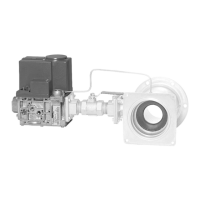V4730C/V8730C/V4734C · Edition 05.23
EN-4
5 TIGHTNESS TEST
5.1 Checking for tightness
This is a test for checking the closure tightness of
the gas shutoff valve.
It should be performed only by trained, experienced,
flame safeguard technicians during the initial startup
of the burner system or whenever the valve is
replaced.
It is recommended that this test should also be
included in the scheduled inspection and mainte-
nance procedures.
For a periodic inspection test, also follow steps
below.
WARNING
Electrical Shock Hazard. Can cause severe injury
or death.
Please observe the following:
– Remove the power from the system before
beginning the valve leak test to prevent electrical
shock. More than one disconnect may be
involved.
1
De-energize the control system to make sure no
power goes to the valves.
2
Close the upstream manual gas cock A.
SSOV
3)
SSOV
3)
2)
D
F
4)
upstream
manual
gas cock
gas
supply
downstream
manual
gas cock
manual test
pet cock
1)
jar or glass
with water
1/4“ (5 mm) aluminum
or copper pilot tubing
1/4“ (5 mm)
flexible tubing
angle
1/2
(13 mm)
Valve leak test
1) Can also be a permanent petcock
2) Pressure regulator
3) Safety shut-off valve
4) Use the downstream tap on the SSOV
3
Make sure the manual test petcock F is closed in
the leak test tap assembly.
4
To test the first SSOV (safety shut-off valve),
remove the 1/8" (3mm) NPT plug from pressure
tap point P.
1 4
5
Install the leak test tap into pressure tap point P
on the valve body.
6
Open the upstream manual gas cock A to re
pressurize the first SSOV B.
7
Immerse the 1/4" (6mm) tube vertically 1/2"
(13mm) in a jar of water.
8
Slowly open the manual test petcock F.
9
When the rate of bubbles coming through the
water stabilizes, count the number of bubbles
appearing during a 10–second period.
➔ Each bubble appearing represents a flow rate of
0.001 cfh (28 cm
3
/h). See table "Max. bubbles
per pipe size".
10
Close the upstream manual gas cock A.
11
Remove the leak test tap from the valve body.
12
Using a small amount of pipe sealant on the 118"
(3mm) NPT plug, reinstall the plug in pressure
tap point P
13
To test the second SSOV, remove the 1/8 in.
(3mm) NPT plug from the flange pressure tap
point 4.
14
Install the leak test tap into pressure tap point 4.
15
Close the downstream manual gas cock E.
16
Energize the first SSOV B.
Max. bubbles per pipe size
Pipe
size ("
NPT)
Maximum seat
leakage (UL) in
cch
Maximumnum-
ber ofbubbles in
10 second
1/2–3/4 235 6
1 275 7
1–1/4 240 8
17
Immerse the 1/4" (6mm) tube vertically 1/2"
(13mm) into a jar of water.
18
Slowly open the manual test petcock F.
19
When the rate of bubbles coming through the
water stabilizes, count the number of bubbles
appearing during a 10-second period. Each
bubble appearing during a 10- second period
represents a flow rate of 0.001 cfh (28 cm
3
/h).
See table "Max. bubbles per pipe size".
20
De-energize first SSOV.
21
Remove the leak test tap from the valve body.
22
Using a small amount of pipe sealant on the 1/8"
(3mm) NPT plug, reinstall the plug in pressure
tap point 4.
After the Test
23
Make sure the downstream manual gas cock E
is closed.
24
Open the upstream manual gas cock A and
energize the valve through the safety system.
25
Test with rich soap and water solution to make
sure there is no leak at the test tap D or any pipe
adapter/valve mating surfaces.
26
De-energize the valve C.
27
Open the downstream manual gas cock E.
28
Restore the system to normal operation.

